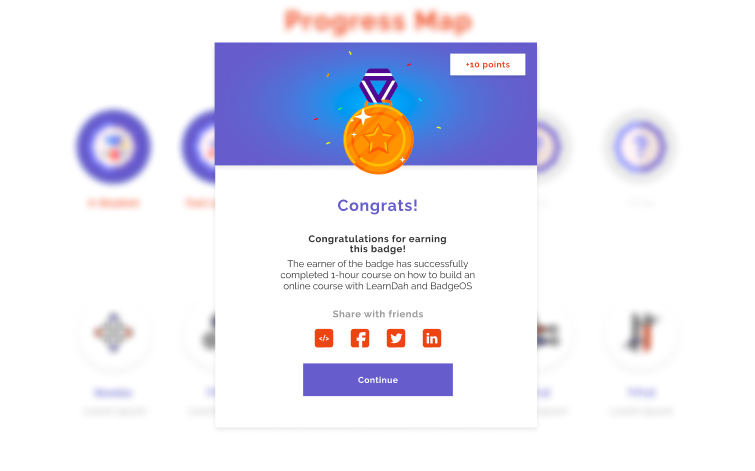Online course gamification sets the popular e-learning platforms from the ones that learners barely touch. Students prefer engaging lessons that are fun to learn. For this reason, instructors need to create online courses that draw learners’ attention and motivate them to engage.
Through gamification, instructors integrate gaming elements into eLearning resources to enhance engagement. The game elements include points, levels, leaderboards, competition, game-based problem solving, virtual reality, augmented reality, and other game mechanics.
The goal of online course gamification is to make them motivating and engaging and to allow users to have fun as they learn.
Ways Gamification Enhances eLearning
Integrating gamification strategies in eLearning enhances engagement and makes learning dynamic. Here are the ways game elements make the eLearning experience better.
1. Fosters Better Learning Experience
Gamification enhances the learning experience in several ways. It allows learners to get hands-on experience by applying lessons and skills in practical scenarios. On-the-job learning helps them cement critical skills gained in the coursework.
Through the game elements, they can see real-world applications clearly and see the results of their choices.
Gamification concepts such as leaderboards, badges, prizes, and success levels in online courses allow learners to take stock of their performance and find ways to improve.
2. Creates a Motivating and Inspiring Learning Environment
Well-designed game concepts in online courses can inspire and motivate learners. Gamification elements that allow learners to see their course progress bring intrinsic motivation that encourages learners to take more steps to achieve the bigger goal.
Levels integrated into the online learning management systems make progress easy to see, igniting motivation. Learning that features pleasurable activities encourages students to engage with the course materials.
Prizes, certificates, and badges integrated into the courses serve as reward systems that motivate students to perform better.
3. It Challenges Learners to Want to Learn More
Gamification elements inspire and motivate learners to learn due to the exciting nature of the course tasks.
The course motivates and encourages learners to learn more when they enjoy the content. Gamification concepts that reward learners after completing smaller and frequent tasks and the changing difficulty levels challenge students to learn and achieve more.
By getting exciting opportunities to interact with the content, students look forward to more challenging and rewarding challenges and learn actively.
4. Makes Learning Fun
Instructors use gamification elements to make their courses fun and engaging. Enjoyable courses make learning less of a chore, and something students want to invest their time in.
Instructors make the courses fun by creating opportunities for learners, instructors, and parents to collaborate. Achieving easy tasks and progressing to more challenging tasks makes learning fun and focuses the learners’ attention on the goal.
5. Accelerates the Learning Process
The motivation, challenges, and fun from gamified learning content accelerate the learning process. When learners meet their goals and move to the next level in the courses, it ignites motivation for continuous learning. Students feel there is more to achieve and score.
Students stay engaged with the course material longer and remain productive longer.
Ten Ways to Use Gamification Elements in Online Courses
Gamification creates opportunities for an engaging learning experience that supports achievement for learners. Here are ways instructors can use gamification elements to create exciting courses that stand out.
1. Unlock Learning Materials Incrementally
Most online courses allow students to access content in a time-based approach. For instance, they can complete a module or two per week. Some instructors allow learners to access all the course materials in one go.
Integrating a system that makes students unlock the courses incrementally is an engaging approach to distributing course materials. You can design coursework with different difficulty levels where students can graduate from one level to the next. If you have integrated a gamification system into your site, you can also allow students to collect points through their assignments and quizzes and use them to unlock additional modules.
Allowing students to unlock courses in succession and when they have completed the previous level will make them learn more and build the diligence of going through all the coursework.
This approach allows educators and parents to monitor learners’ progress and send them reminders to complete courses or give them support.
Give learners a smooth learning curve where they can start with simple topics and assessments to allow them to build confidence to handle the more challenging topics later.
2. Allow Students to Work in Teams
Educators can use gamification elements to enhance collaboration among learners in eLearning. Concepts such as group tasks and assignments can boost cooperation. Instructors can set up a debate and have students share their points on discussion boards.
Students competing against each other in teams in ways that promote cooperation can keep their motivation high. Course creators should integrate gamification concepts that allow them to work in teams.
For instance, leaderboards, points, progression bars, and rewards can motivate learners to work together to achieve their goals and receive collective rewards.
3. Monitor and Reward Progress

Integrating progress bars in online courses will help learners see how far they have gone with the courses and how much they have achieved. Automated notifications and alerts can remind students to progress with their coursework from where they stopped.
Most learners feel motivated when instructors acknowledge their progress. A progress bar that shows learners move incrementally in the different course levels can motivate them. Rewards such as unlocking new courses or grades, badges, and certificates can enhance students’ motivation and keep them engaged with the coursework.
Learners can earn points by participating in group discussions and debates. Instructors can allow the learners to redeem the points by unlocking new course levels.
4. Create Leaderboards

Leaderboards allow students to compete with their peers while engagingly building skills.
You can integrate leaderboards and provide learners instructions on how to get to the top. Instructors can award learners points based on criteria such as their overall performance, quiz scores, and the number of completed modules.
The gamification concept is an effective way to keep learners engaged in an online course. Leaderboards can promote high-performance habits among students in eLearning to help achieve positive outcomes. Instructors can collect feedback from the learners through surveys to gauge the effectiveness of the leaderboards and identify ways to improve them.
The gamification element is a great way to foster healthy competition and collaboration among learners. Instructors can create separate leaderboards for teams to better collaborate and compete.
Instructors should make leaderboards visible to the learners to remind them to enhance their performance. Position the leaderboards on the signing-in page of the learning management systems and other relevant locations such as before quizzes and assessments to stay in the learners’ minds.
Instructors can integrate relevant rewards into the learning boards to make them more effective. Consider the individual needs of the learners and personalize the rewards. Students can redeem points or get tangible and intangible rewards from the performance showcased by the leaderboards.
5. Integrate Gamified Quizzes with Instant Feedback
Regular gamified quizzes enhance learning as students have to recall information more frequently, enhancing information retention.
Instructors can gamify quizzes by integrating video to make them more interactive. Educators can distribute quizzes to learners in a competitive approach where learners can compete against each other and earn points.
Using gamified quizzes as attention-getters at the beginning of a new module can activate prior knowledge and boost a learner’s engagement with the new module. Gamified quizzes in the middle of the course can help learners prepare for summative assessments.
Students can use the points earned in the quizzes to unlock free learning resources or get extra trials on an upcoming assessment.
Giving learners quizzes with instant feedback will motivate learners to engage with the course. Feedback can be rewards, privileges, points, or unlocking new modules. Instructors can gamify their quizzes by providing the correct solutions to problems after scoring the students.
6. Add Countdown Timers

Countdown timers are a fun and effective way to boost engagement. Instructors can use countdown timers to remind learners to complete modules or assignments by creating a sense of urgency.
Timers can add the element of competition to online courses. Learners love competition, whether it is competing against their peers or time. Instructors can make learning more fun by timing assessments and quizzes.
For instance, they can set a quiz for learners to complete within 5 minutes.
They can time different teams on discussion boards when sharing points in debates. They can integrate time management in scoring the overall performance of a task. For instance, students can earn points by completing the tasks within the allocated time.
Instructors can integrate timers with alerts and notifications to remind students of pending modules, assignments, and assessments.
7. Avatar Upgrades and Customizations
Integrating avatars in the eLearning environment can increase the interactivity of online courses. Avatars are practical gamification elements, and instructors can use them to represent different levels in the lessons. For instance, learners can upgrade their avatars when they complete a level or achieve a pass mark.
Avatars can personalize the online learning experience. Instructors allow students to customize avatars that represent them effectively as individuals. They can also customize their avatars to represent their characters when participating in debates or team tasks.
Instructors can also use avatars to share important information about the modules at the beginning of the course. Using avatars within the course materials to guide learners will boost their memory.
Using suitable avatars at the right time can help gamify eLearning and make online courses interactive.
8. Personalization and Customization of the Learning Experience
Instructors can use gamification to promote personalized learning to create meaningful engagement and experience. For instance, through gamified quizzes with instant feedback, learners can get the information they need to change their study techniques to achieve their academic goals.
Instructors can create personalized learning paths for students by giving assessments based on their strengths and competencies. Unlocking the course materials incrementally as students complete introductory modules can motivate students to learn.
Successive assessments that begin with the simpler questions that graduate into more complex ones allow the customization of the learning experience depending on the learner’s level of comprehension of the coursework.
Personalized recommendations and feedback based on a student’s behavior can help them further build their knowledge and skills. Educators can use several gamification elements such as avatars, gamified quizzes, badges, and points to personalize a learner’s experience and give them autonomy.
9. Giving Second Chances in Assessments and Quizzes
Online course gamification can include game-like assessments and quizzes that enhance the learning experience and keep learners motivated. Instructors can use the technique to integrate gamification into their online courses.
Giving learners second chances on assessments and quizzes will increase their confidence and satisfaction with the course. They get opportunities to master the materials to approach assessments differently, increasing the chances of success.
The second chance will allow students to remediate the feedback provided. This allows them to revisit the course and learning materials to improve the outcome, and in the process, they retain the information longer.
10. Storytelling

Instructors can use storytelling to make learning more memorable and the content more engaging. While some students love reading, others learn better through a good story. Instructors can gamify their online courses through compelling storytelling that aids a better understanding of content.
An exciting story will draw the users and take them on a learning journey. Compelling storytelling involves using content that tackles the different aspects and topics of the course.
Instructors can integrate avatars, images, audio, videos, and classroom interaction in storytelling to keep it practical and simple. Incorporating characters when in the stories will make the course more fun.
Online Course Gamification
Gamification is not a passing cloud; it is the future of the learning industry. E-Learning instructors have an opportunity to integrate online course gamification into their work to drive positive learning outcomes.
Gamification creates an inspiring and motivating learning environment that encourages learners to engage with online courses. It makes online lessons fun, accelerates learning, and challenges learners to seek more knowledge.
Instructors and educators can integrate gamification in their courses by allowing students to work collaboratively, creating leaderboards, monitoring and awarding progress, and storytelling.
Gamifying your online course might seem complicated at first, but our Gamification experts can help you implement a gamification system quickly and easily. We’ll help you design a unique gamification and reward system for your site and implement all the technical solutions required to make your online course as engaging as can be!




